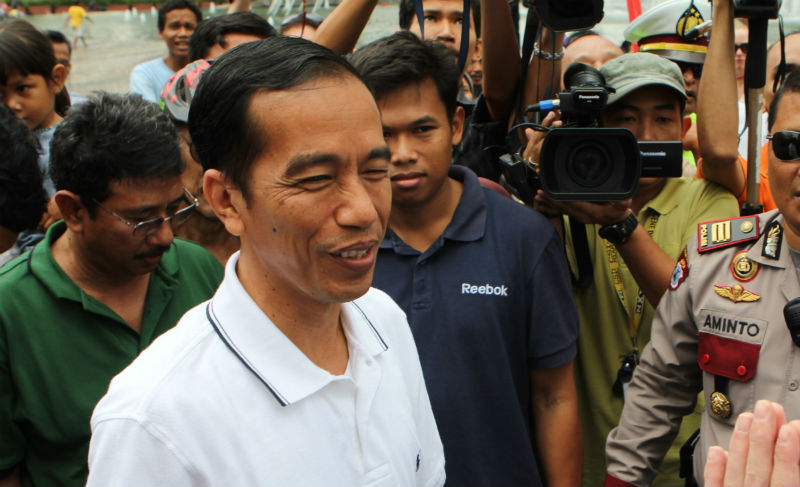 Indonesian President Joko Widodo, target of fake news attacks
Indonesian President Joko Widodo, target of fake news attacks
Fake news — including fake science news — is taking the world by storm. So much so that governments all over the world are now threatening action, in some cases along the lines of what they did earlier to traditional media.
Sample these headlines:
- Pope backs Trump
- Hillary sells weapons to ISIS
- Weather Channel founder tells CNN “climate change is a hoax”
- Deodorant, vitamin E, chips, tomatoes increase chances of developing cancer.
- Are genetically-modified crops ‘Frankenstein’ foods?
The first two went viral on Facebook in the run up to the 2016 United States elections and gained so much attention that the news outlet BuzzFeed published an analysis on how they had outperformed real news on Facebook. Fake news items such as these appeared on regular and social media channels and were swallowed up by millions of people in recent months.
On the science front, one example of fake news includes articles downplaying the fact that cigarette smoking and second-hand smoke are bad for human health. Ivan Oransky and Adam Marcus, co-founders of the website Retraction Watch, which detects academic papers withdrawn due to questionable findings, have also reported a claim that jet plane vapour trails contain toxic materials, not just ice crystals.
Other questionable studies include those that linked vaccines to autism, a connection that has long been debunked, and one that claimed HIV doesn’t cause AIDS.
Modern-day propaganda
Fake news is fabricated with the intention of misleading readers, usually for political gain or economic profit. It has been defined as “a catch-all term encompassing propaganda, misinformation, disinformation and hoaxing — including the spheres of science and medicine”.
Before the term fake news became popular, people would often use the term propaganda, which has been used since ancient times for political gain. The Roman consul, Octavian, is said to have resorted to disinformation to win his wars against Marc Anthony. During the first and second World Wars, the US and British governments used propaganda effectively in the struggle against Germany.
Enter the Internet and the fake news economy. Here we see small groups of people taking advantage of sensational news items to build up readership for advertising and to influence people. Internet fake news is similar to propaganda in that both “distort the truth for emotional persuasion, seeking to drive action”.
US President Donald Trump can be credited with popularising the term fake news. At his first press conference as President-elect in 2016, he railed at journalists interviewing him: “You are fake news!” Since then, Trump has regularly made similar accusations against major media outlets on his Twitter feed.
In Asia, fake news is spread mainly for political rather than economic or scientific reasons.
In the 2015 Indonesian elections, it was used to portray current president Joko Widodo as having an ethnic Chinese and a Catholic background in a Muslim state. But it did not affect his popularity. In the 2016 Philippine election, President-elect Rodrigo Duterte reportedly had an army of ‘trolls’ to regularly post propaganda on social media. His trolls even received partial credit for his victory.
In India, Prime Minister Narendra Modi, once a spokesman for his Bharatiya Janata Party, is said to have come to power in 2014 through support from well-oiled troll machinery working on his behalf.
A step from science illiteracy
Analysts believe the proliferation of fake news is fuelled in part by lagging educational standards. Populations that are largely unschooled can be easily duped. Although this is especially the case in developing countries of Asia and Africa, fake news spreads more easily among less educated sections of society in Europe and the United States too.
It takes just one small step to get from superstition to belief in fake news. Science illiteracy easily leads to false beliefs. Ignorance breeds gullibility.
Fake news in turn undermines scientific credibility and erodes public trust in science, especially in underdeveloped countries with an unschooled public where public trust is low to begin with.
This makes it imperative for scientists to take every opportunity to expose fake news for what it is. In the United States, some initiatives have been taken to teach students how to spot false reports. But more can be done — for example, the National Academy of Sciences should make part of their mandate a campaign against this type of misinformation.
The case for media literacy and science education becomes urgent in the digital era, where 60 per cent of the population gets its information from social media.
This is a challenge that also calls for the providers of social media platforms, like Facebook, Instagram and Twitter, to strengthen their efforts to police their platforms — better to self-police than get policed by government.
If self-censorship fails to stem the tide of fake news, there is a real danger of governments taking over social media regulations in developing societies. The signs are already there in South East Asia, as Indonesia’s Human Rights Watch researcher Andreas Harsono has warned.
Many governments in the region are already using the fake news phenomenon to label most media criticism as false, opening the way for state regulation of social media.
Singapore is now studying the possibility of introducing a law to “force social media companies to remove misleading reports,” says Singapore law and home affairs Minister Kasiviswanathan Shanmugam. Shanmugam says he was inspired by German Chancellor Angela Merkel to introduce legislation to “force social media companies to withdraw fake news stories from the Internet in as fast as 24 hours or else face penalties.”
That is the writing on the wall.
This article was originally published by SciDevNet



Rate and Review
Rate this article
Review this article
Log into OpenLearn to leave reviews and join in the conversation.
Article reviews